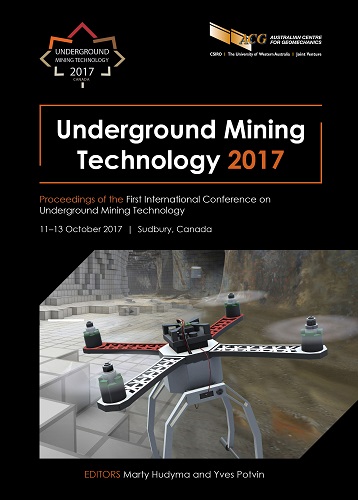Design and construction of a prototype for acidity level control in coal mining liquid effluents

|
Authors: Salamanca, JM; Rodríguez, HE; Moreno, MM |
DOI https://doi.org/10.36487/ACG_rep/1710_56_Salamanca
Cite As:
Salamanca, JM, Rodríguez, HE & Moreno, MM 2017, 'Design and construction of a prototype for acidity level control in coal mining liquid effluents', in M Hudyma & Y Potvin (eds), UMT 2017: Proceedings of the First International Conference on Underground Mining Technology, Australian Centre for Geomechanics, Perth, pp. 663-675, https://doi.org/10.36487/ACG_rep/1710_56_Salamanca
Abstract:
It is a challenge of modern industry to develop processes that do not pollute the environment, most importantly water. The mining industry is no exception, and in turn must minimise environmental impact on water sources in or around areas of exploitation (Garner et al. 2012). The management of drainage in the depth of the mine is a problem due to high costs, and it is important to understand that the cost of the consumption of electric energy rises according to the size of the mine and the quantity of drainage. This paper describes the design and implementation of a prototype to neutralise the acid water of mining in the didactic coal mine located in Morcá (Sogamoso, Colombia), which belongs to the Centro Nacional Minero (National Mining Centre), Servicio Nacional de Aprendizaje (SENA, Sogamoso, Colombia). The neutralisation of these acidic waters aims to minimise the environmental impact produced by these liquids, when they are discharged into nearby water sources. The neutralisation method is ‘additives base’, which comprises mixing a basic agent; in this case, caustic soda (NaOH) at a concentration of 1 Normal (1N) was used. In order to carry out this process, the system model is estimated and proportional plus integral (PI), algebraic, fuzzy logic and sliding mode controllers were applied to the prototype. A comparison of the performances of the different controllers showing the response time overshoot, steady state error and magnitude of the control signals are shown and analysed.
Keywords: pH, acid water, caustic soda
References:
Åström, KJ & Hägglund, T 2006, Advanced PID Control, ISA-The Instrumentation, Systems, and Automation Society, Research Triangle Park.
Åström, KJ & Wittenmark, B 2011, Computer-Controlled Systems: Theory and Design, 3rd edn, Dover Publications, Mineola.
Banzi, M 2011, Getting Started with Arduino, O'Reilly Media, Sebastopol.
Barettino, D & Pérez, JL 2005, Acidificación de Suelos y Aguas: Problemas y Soluciones, Instituto Geológico y Minero de España, Madrid.
Bequette, BW 1998, Process Dynamics: Modeling, Analysis, and Simulation, Prentice Hall, Upper Saddle River.
Betancourt, DP & Ramírez, JL 2007, ‘Por medio de la cual se señalan características, instrumentos básicos y frecuencias del sistema de control y vigilancia para la calidad del agua para consumo humano’, Resolución Numero 2115, Ministerio de la Protección Social, Ministerio de Ambiente, Vivienda y Desarrollo Territorial, Bogota.
Bojadziev, G & Bojadziev, M 1996, Fuzzy Sets, Fuzzy Logic, Applications, World Scientific Publishing Co., Inc. River Edge.
Distefano III, J, Stuberud, A & William, I 1992, Retroalimentación y Sistemas de Control, McGraw-Hill, Contadero.
Evangelista, CA 2012, Control de Sistemas no Lineales por Modos Deslizantes de Segundo Orden, PhD thesis, Universidad Nacional De La Plata, Buenos Aires.
Garner, R, Naidu, T, Saavedra, C, Matamoros, P & Lacroix, E 2012, Water Management in Mining: A Selection of Case Studies, International Council on Mining & Metals, London.
Goilav, N & Loi, G 2016, Arduino: Aprender a desarrollar para crear objetos inteligentes, ENI, Rome.
Kang, J, Wang, M & Xiao, Z 2009, ‘Modeling and control of pH in pulp and paper wastewater treatment process’, Journal of Water Resource and Protection, vol. 1, pp. 122–127.
Kemmer, FN, McCallion, J & Company, NC 1989, Manual del agua: su naturaleza, tratamiento y aplicaciones, McGraw-Hill, Contadero.
Kiam Heong, A, Chong, G & Yun, L 2005, ‘PID control system analysis, design, and technology’, IEEE Transactions on Control Systems Technology, vol. 13, no. 4, pp. 559–576.
Monguí-Galvis, AM, Puentes-Balaguera, EA & Ortega, R 2015, ‘Diagnóstico y plan de gestión de manejo ambiental mina didáctica del SENA Facultad - Área de ingeniería’, Ecomatemático, vol. 3, no. 1, pp. 74–83.
Passino, KM & Yurkovich, S 1998, Fuzzy Control, Addison-Wesley, Boston.
Pedrera, AC 2017, Arduino para Principiantes, 2nd edn, Createspace, Scotts Valley.
Rivero Ochoa, EE & Chávez Cuadros, T 2010, Diseño de una planta piloto para el tratamiento de aguas ácidas de mina, mina "Las Peñitas", en la vereda de Reginaldo, minicipio de Monguí - Boyacá, Universidad Pedagógica y Tecnológica de Colombia, Sogamoso.
Russell, DL, Ruiz, JB & López, JC 2012, Tratamiento de Aguas Residuales: Un Enfoque Práctico, Editorial Reverté S.A., Barcelona.
Salamanca, J 2009, Analisis y Control con Modelos Algebraico Diferenciales Lineales de la Estabilidad en Pequea Seal en Sistemas de Potencia Electrica, PhD thesis, Universidad del Valle, Cali.
Salamanca, J, Rodríguez, EA & Rosas, RP 2010, 'Control por LMI-Modos deslizantes aplicado a una clase de sistemas no lineales', Proceedings of VIII Congreso Internacional sobre Innovación y Desarrollo Tecnológico, Institute of Electrical and Electronics Engineers, Piscataway.
Smith, CA & Corripio, AB 2006, Principles and Practice of Automatic Process Control, John Wiley & Sons, Hoboken.
© Copyright 2026, Australian Centre for Geomechanics (ACG), The University of Western Australia. All rights reserved.
View copyright/legal information
Please direct any queries or error reports to repository-acg@uwa.edu.au
View copyright/legal information
Please direct any queries or error reports to repository-acg@uwa.edu.au